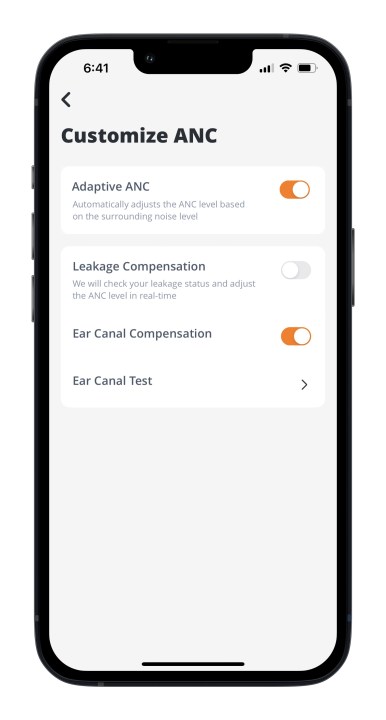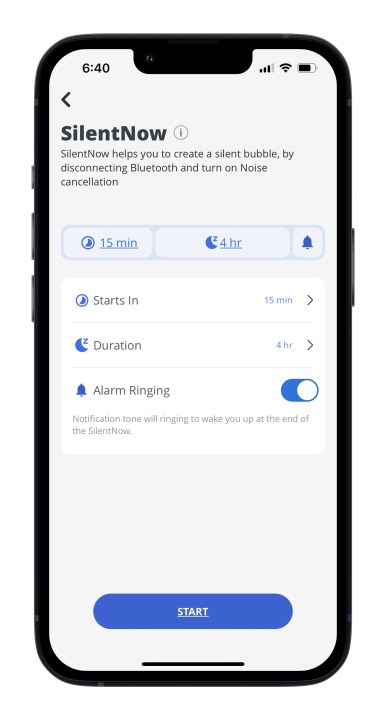JBL Tour Pro 2
MSRP $250.00
“They’re easily the most feature-rich wireless earbuds you can buy.”
Pros
- Tons of features
- Very good ANC
- Solid sound quality
- Strong battery life
- Custom EQ and controls
Cons
- So-so call quality
- No high-quality codecs
- Smart case doesn’t add a lot of convenience
Rumors began to swirl that Apple might be considering the addition of a touchscreen to the charging case of the AirPods Pro 2. This was followed up by a rendering that imagined what such a touchscreen case might look like. Reactions to the concept were varied, from enthusiastic, to deeply skeptical. Digital Trends’ own Christine Chan was among the latter, claiming it was the worst thing she had seen that week.
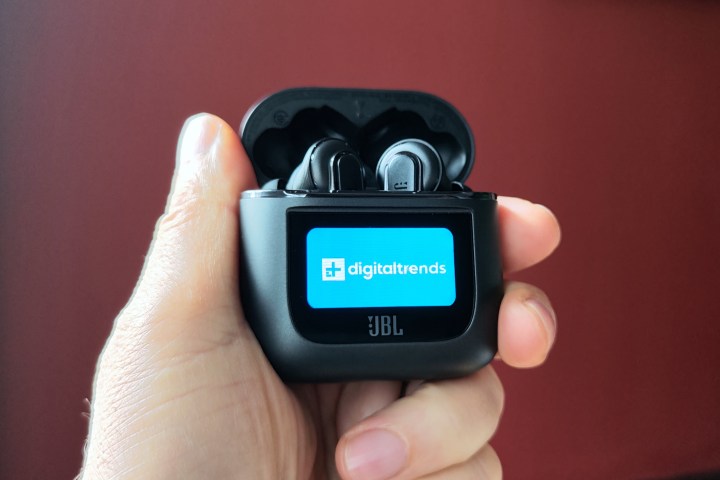
Most of the objections, including Chan’s, were simply about the utility of adding a touchscreen to an object that really only exists in order to charge and protect a set of earbuds when not in use. Does it really make any sense? We may never know for sure — Apple’s patent applications rarely see the light of day as actual products — but we’ve got a very good idea thanks to JBL’s new $250 Tour Pro 2 wireless earbuds.
Among the many enhancements to JBL’s second-gen Tour Pros, the most notable by far is the inclusion of a touchscreen on the charging case, which is almost exactly what the Apple patent appears to describe.
JBL’s version of the smart charging case lets you perform a wide variety of actions without removing your phone from your pocket. Ordinary things like playback and volume control, less ordinary things like changing how the earbuds respond when you remove them from your ears, and even some really extraordinary things like using the built-in screen as a flashlight. It can even flash a notification and the first dozen or so characters from an incoming email.

Some functions are always present on the case (e.g. playback) and some are optional — you can decide how many of the optional ones are included using the JBL Headphones app for Android and iOS.
The case itself is a bit bulky, but not much bigger than the Bose QuietComfort Earbuds II or Bowers & Wilkins Pi7 S2, so JBL still deserves props for keeping things relatively compact.
The screen is surprisingly responsive and with the included brightness control (yet another function) it’s easy to read even in relatively bright light. You unlock it with a single swipe from left to right. But the question remains: is it easier to use your charging case than your phone? Most wireless earbuds — the Tour Pro 2 included — come with plenty of controls built into the actual buds, making several of the case-based options mere duplicates (triplicates if you include your phone). Of the remaining options that can’t be performed with the buds, how often do you really need to access them?

I definitely enjoyed playing with it — there’s a real novelty factor to it — but I mostly use my earbuds when I’m out for a walk or going to the gym and in both situations, I leave my charging case at home. For me, that makes it hard to develop a habit where I’d reach for the case instead of my phone (or the earbuds).
Most of the features are only relevant when the buds are connected to your phone, like playback, volume, spatial sound (I’ll get to that in a moment), and EQ settings. However, some remain useful even with no connection at all, like ANC, reminder timers, find my buds, and the flashlight.
In fairness, the whole case versus phone choice may be a red herring. If you’re using the Tour Pro 2 with a computer or tablet (or even a second phone) that doesn’t have the JBL Headphones app installed, the case can give you access to nearly every one of the app’s settings — that’s pretty handy.

Still, I can’t help but wonder about the other phone-less features that JBL could have included that might have made the Tour Pro 2’s smart case even more useful. It could act as a Bluetooth transmitter for times when you need to plug into a physical headphone jack (airplanes) — the Bowers & Wilkins Pi7 S2 does this — or it could have a small amount of built-in music storage for times when you don’t want to bring your phone with you, like an Apple Watch.
Those examples will likely never come to pass, but here’s one that might: With support for Bluetooth 5.3 and LE Audio, the Tour Pro 2 will probably be Auracast-compatible when this clever Bluetooth broadcast technology rolls out. At that time, you may be able to use the case to discover and connect to Auracast streams, with no phone needed.
For the Tour Pro 2, JBL abandoned the round, all-in-one earbud style it used on the original Tour Pro+ in favor of a more AirPods-like stem design. That was a good move in terms of comfort — the Tour Pro 2 don’t make your ears feel as full as the first version — I’ve worn them for hours with no problems. However, it’s not as easy to get a super-secure fit. So while the IPX5 water-resistant rating makes them robust enough to survive sweaty workouts or runs, you may find they don’t stay put through high-impact activities.

Speaking of Apple’s buds, the Tour Pro 2 offer a compelling alternative to the AirPods Pro 2 when it comes to sound quality. Depending on your settings, the two models can sound very similar, but JBL has a big advantage here: a highly customizable 10-band equalizer with factory presets and the ability to create and save your own custom recipes.
When pushed, these tweaks can give the Tour Pro 2 a big, commanding bass response, or they can be used to give the mids and highs greater presence. Admittedly, without any advanced Bluetooth codec support (they’re SBC/AAC only), these earbuds can’t live up to their full potential, but JBL goes a long way to make them sound great. Not only do you get adjustable EQ — but you can also leverage some new tools like Personi-Fi, which attempts to personalize the EQ based on your age, sex, and ability to hear various frequencies.
I’ve used lots of these systems over time and sometimes they produce impressive results, and other times, not so much. Personi-Fi accurately assessed my slightly diminished high-frequency sensitivity, though when I flipped the personalization setting on and off, I couldn’t hear much of a difference.
The Tour Pro 2 also attempt to compete with the AirPods Pro 2 in the realm of spatial audio, but in this case, I think the Tour Pro 2’s approach is less effective. Enabling spatial sound will take whatever you’re listening to and apply one of three digital signal filters: music, movies, or gaming. Each accentuates a different aspect of your sound — movie mode goes for a cinematic effect, music tries to create a greater sense of realism, while gaming enhances the precision of high-frequencies so you can develop a better idea of what’s happening inside your game.
You should think of them as three more EQ presets that you can play with. If you like them, great — go nuts. If you don’t, leave them turned off. But they are not the same thing as listening to an actual spatial audio source, like Dolby Atmos for movies, or Dolby Atmos Music. Moreover, they do not perform the same trick as Apple’s head-tracking for spatial audio, which alters the presentation of spatial audio based on your head movements.

I liked the sound of JBL’s filters — movie mode was my favorite — but I still prefer the sound of Dolby Atmos content. The good news is that missing head-tracking aside, these buds will still let you hear Dolby Atmos and Dolby Atmos Music as long as your smartphone and apps support it.
And that’s just the start of a startling list of tech tools that JBL throws your way via the Headphones app. You can perform a fit test, an ear canal test that ostensibly improves active noise cancellation (ANC), and there’s even an option for leakage compensation. Uh, pardon me? It’s sound leakage. ANC requires a strong seal to do its best work, but getting a perfect fit can be hard to achieve let alone maintain, so leakage compensation attempts to correct for those changing seal conditions. It’s the flip side of adaptive ANC, which adjusts itself based on how outside noises change from moment to moment. The Tour Pro 2 has this, too, and you can turn it on and off in the app.
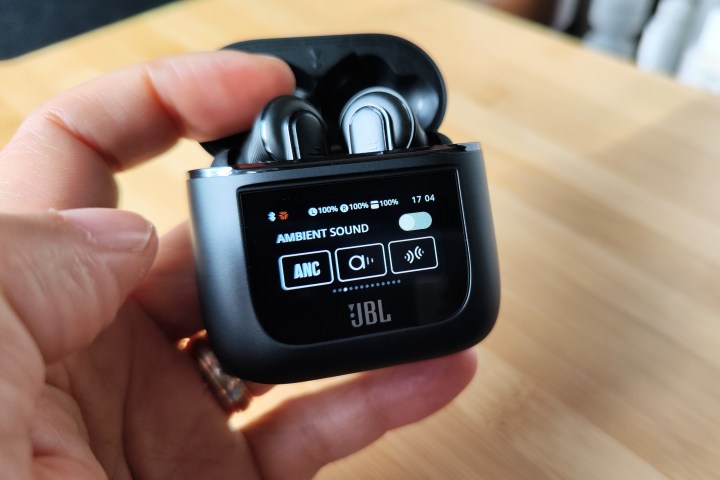
I found ANC on the Tour Pro 2 very effective at blocking a variety of sounds from traffic to the whine of a vacuum, and it even helped reduce the intrusion of nearby conversations as I was trying to write this review. It’s at its best when you’re listening to podcasts, preserving the sound of hosts’ voices even in very noisy environments. It also works well as a tool for diminishing unwanted sounds when you’re not listening to anything at all, although in this situation, you’ll get the best results by using the Silent Now option. This disconnects the Tour Pro 2 from Bluetooth entirely and leaves ANC mode on. You won’t get any notifications or distractions. You can set the duration for Silent Now and the buds will automatically reconnect when the time is up.
This not only preserves battery life but also deals with an anomaly in how the earbuds work with audio connections to your phone or computer. When you’re not listening to any audio, the Tour Pro 2 still react to small changes in your device’s activity — like an incoming text message notification — which can affect how ANC works. It usually presents itself as a slight hiss that sticks around for a minute or two and then goes away until the next notification. Silent Now eliminates this.
The Tour Pro 2 has four versions of transparency. Ambient mode lets in as much outside sound as you want, TalkThru does the same thing but also dips the volume of any audio that’s playing so you can have a conversation, VoiceAware (sidetone) lets you adjust how much of your own voice gets piped back into the earbuds during phone calls, and Personal Sound Amplification is designed to make conversations easier in busy environments.
All four do an excellent job of bringing the outside world in, for greater awareness of your surroundings, but even at their maximum settings, my voice did not sound natural to me — nowhere near as truly “transparent” as the AirPods Pro 2. This diminished the value of TalkThru, VoiceAware, and Personal Sound Amplification.
Call quality on the Tour Pro 2 is surprisingly poor. Not poor in the sense that it’s bad — it’s not. Compared to many other wireless earbuds, it’s on par. I mean poor in the sense that it’s worse than on their predecessors, the Tour Pro+, and much worse than the similarly-priced AirPod Pro 2. Background noise is very effectively canceled, but my voice paid the price for this aggressive processing, becoming warbly and compressed-sounding in anything but the quietest of locations. If you’re primarily using them indoors, it won’t be a problem, but when outside, your callers will be aware of it.
Unbelievably, we still haven’t touched on all of the Tour Pro 2’s features. So before your eyes completely glaze over, let me give you the broad strokes. The charging case will charge wirelessly on any Qi charger, or you can plug it in with the included USB-C cable. When fully charged, it can recharge the earbuds three times from empty.
Battery life on the buds themselves is decent when using adaptive ANC, at a claimed six hours, better when you use non-adaptive ANC (eight hours), and very good when turning ANC off (up to 10 hours). Under ideal conditions, that means you can get as many as 40 hours of play time without needing a power source.
Keep in mind, these numbers all assume a 50% volume level, which may not be loud enough in all situations.
The earbuds have wear sensors and they can be turned on or off depending on whether you want auto-play/pause when you insert or remove them from your ears. I found it was very responsive when turned on.
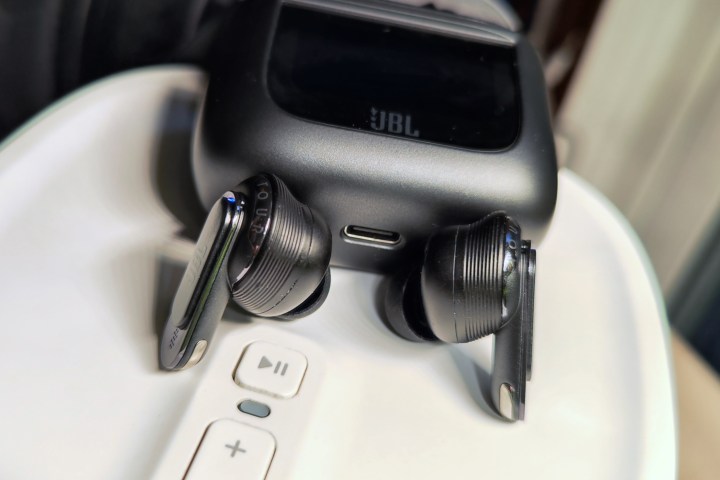
You can use each earbud independently, and they support Bluetooth Multipoint for connecting two devices simultaneously — a very handy feature for jumping between a phone and a computer. It worked very well, with one exception: when connected to an iPhone and a Mac, the JBL Headphones app wouldn’t always recognize the earbuds. The fix was to disconnect the Mac, open the app, then reconnect the Mac. I didn’t have the same problem with two simultaneous smartphone connections (e.g. iPhone/Android).
Google Fast Pair and Microsoft Swift Pair are both supported, for one-tap/click pairing on compatible devices.
The Find My Buds feature is rudimentary — there’s no Bluetooth location tracking in the app — but it can still be effective: one or both earbuds can be forced to emit a very loud tone to help you find them. It does not work if the buds are in the case, and unlike the AirPods Pro 2, you get no help in locating a misplaced case.
The notifications on the case — for texts or emails, etc. — is only moderately useful. If the case happens to be located where you can see it, you may notice the very quick, one-line message pop up, but if you miss it, there’s no way to get it back. A small envelope icon in the corner of the screen is your only clue that you missed one.
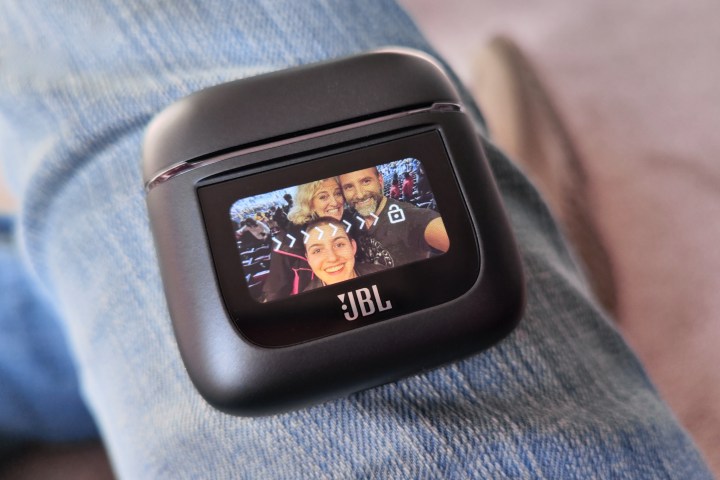
The lock screen art can be customized in the app. In the accompanying photos, you can see the Digital Trends logo that JBL preloaded onto our review sample, but you can use almost any image you like.
Your phone’s default voice assistant can always be triggered from the earbuds, but Amazon Alexa is also an option on both iOS and Android.
Finally, JBL even gives you some choices when it comes to controls. It’s not nearly the level of customization offered by Jabra or Sennheiser, but each earbud can be assigned one of three function groups: ambient sound control (for all ANC-related features), volume control, and playback/voice assistant control. Unfortunately, you can’t have all three at once, so some tradeoffs must be made.
If there were a prize for the most tricked-out set of wireless earbuds, the JBL Tour Pro 2 would win by a mile. No contest. It’s hard to think of a single feature JBL has left us wanting, with the possible exception of better Bluetooth codecs like LDAC or the aptX family. They’re comfy, they sound very good, and their ANC is more than capable. With excellent battery life and a charging case that is undeniably unique, I was only really let down by the Tour Pro 2’s handling of my voice both on calls and generally when using transparency modes.
Still, for the price, JBL’s latest flagship earbuds offer a ton of value.
Editors’ Recommendations


